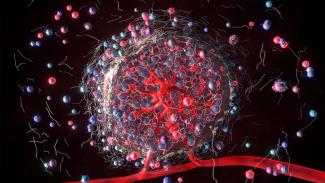Innovative new research in basic biology from the Guo lab reveals how cancer cells cripple one of the newest tools in cancer treatment, CAR T cell therapy.
Researchers from across Penn collaborated to discover how solid tumors communicate with engineered cancer-fighting cells causing them to commit fratricide and inhibit treatment. Their findings point toward improved therapies for treating cancers.
In Lewis Carrol’s “Through the Looking Glass,” protagonist Alice races with the Red Queen and is unable to gain a lead despite her best efforts. “Now, here, you see, it takes all the running you can do, to keep in the same place. If you want to get somewhere else, you must run at least twice as fast as that!” the Queen yelled.
Biologists have co-opted this story to explain why organisms need to constantly adapt in the evolutionary race for survival—dubbing it the Red Queen Hypothesis. And though this analogy has been used most commonly in the context of parasite-host interactions, it also captures the ongoing battle between cancer treatments and tumor evolution: Each time researchers develop a powerful new therapy, tumors evolve new ways to evade, resist, or neutralize it.
Now, a cross-disciplinary team at the University of Pennsylvania has identified a striking example of such biological ingenuity and a way to fight back. Led by Wei Guo of the School of Arts & Sciences, the researchers revealed a mechanism by which solid tumors sabotage chimeric antigen receptor (CAR) T cell therapy by turning the body’s own immune warriors against each other. Their findings are published in Nature Cancer.

